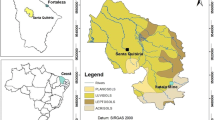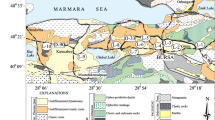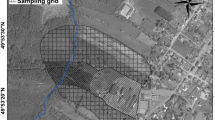Abstract
Simplification of a complex system of geochemical variables obtained from the soils of an industrialized area of Bombay is attempted by means of R-mode factor analysis. Prior to factor analysis, discriminant analysis was carried out taking rock and soil chemical data to establish the anthropogenic contribution of metals in soil. Trace elements (Cd, Co, Cr, Cu, Fe, Mn, Ni, Pb, and Zn) are expressed in terms of three rotated factors. The factors mostly indicate anthropogenic sources of metals such as atmospheric fallout, emission from different industrial chimneys, crushing operations in quarries, and sewage sludges. Major elements (Na, Mg, Al, Si, P, K, Ca, Ti, Mn, and Fe) are also expressed in terms of three rotated factors indicating natural processes such as chemical weathering, presence of clay minerals, and contribution from sewage sludges and municipal refuse. Summary statistics (mean, standard deviation, skewness, and kurtosis) for the particle size distribution were interpreted as moderate dominance of fine particles. Mineralogical studies revealed the presence of montmorillonite, kaolinite, and illite types of clay minerals. Thus the present study provides information about the metal content entering into the soil and their level, sources, and distribution in the area.
Similar content being viewed by others
References
Adriano DC (1986) Trace elements in the terrestrial environment. New York: Springer-Verlag. 533 pp
Alloway BJ (1990) Heavy metals in soils. New York: Halsted Press, John Wiley & Sons, p 339
Anderson TW (1985) Introduction to multivariate statistical analysis, 2nd ed. New York: Wiley. 675 pp
Box GEP (1949) A General distribution theory for a class likelihood criteria. Biometrika 36:317–346
Brady NC (1985) The nature and properties of soil. New Delhi: Eurasia Publishing House. 639 pp
Bridgman HA (1992) Evaluating rain water contamination and sources in southwest Australia using factor analysis. Atmos Environ: Gen Top 26A:2401–2412
Brian R, Robert J, Murphy — and Kyle SW (1982) Anthropogenically derived changes in the sedimentary flux of Mg, Cr, Ni, Cu, Zn, Hg, Pb and P in Lough Neagh, Northern Ireland. Environ.Sci. Technol. 16:23–30
Carver RE (1968) Procedures in sedimentary petrology. New York: Wiley.
Cooley WW and Lohnes PR (1971) Multivariate data analysis. New York: Wiley 365 pp
Davis JC (1986) Statistics and data analysis in geology, 2nd ed. New York: John Wiley Sons 550 pp
Dong A, Cnesters G and Simsimon GV (1984) Metal composition of soil, sediments and urban dust and dirt samples from the Menomone River, Watershed, Wisconsin, U.S.A. Water Air Soil Pollut, 22:257–274
Dupant J (1992) Statistical assessment of surface water quality. Water Air Soil Pollut 61:107–124
Folk RL and Ward WC (1957) A Study of significance of grain size parameters. J. Sediment Petro 27:3–25
Forstner U (1980) Trace metal analysis of polluted sediments, part 1, assessment of sources and intensities Environ Tech Lett 1:494–505
Forstner U and Salmons W (1989) Metals in the hydrocycles. New York: Springer Verlag, p 349
Forstner U and Wittman GTW (1979) Metal pollution in aquatic environment. New York: Springer-Verlag. 486 pp
Furrer OJ, Gupta SK and Stauffer W (1983) Sewage sludge as a source of phosphorus and consequences of phosphorus accumulation in soils. In: Mermite PL and Ott H, (Eds), Processing and use of sewage sludge. Boston: D. Reidel. 279–294 pp
Giblin AN and Dicckson BL (1992) Source, distribution and economic significance of trace elements in ground waters from Lake Tyrrell, Victoria, Australia. Chem Geol 92:133–149
Griffths JC (1967) Scientific methods in analysis of sediments, New York: McGraw-Hill. 508 pp
Hair JF Jr, Anderson RE and Tathom RL (1987) Multivariate data analysis, 2nd Ed. New York: MacMillan. 449 pp
Harman HH (1967) Modern factor analysis, 2nd Ed. Chicago: University of Chicago Press. 468 pp
Kaiser HF (1958) The varimax criteria for analytic rotation in factor analysis. Psycometrica 23:187–200
Kelin LA, Long M, Nash N and Kirschner S (1974) Sources of metals in New York City waste water. J Water Pollut Control 46:2653–2662
Lagerwerff JW and Specht AW (1970) Contamination of road side soil and vegetation with cadmium, nickel, lead and zinc. EnvironSci Technol 4:583–586
Meent DVD, Leeuw JWD, Schenck PA and Salomons W (1985) Geochemistry of suspended particulate matter in two natural sedimentation basins of the river Rhine. Water Res. 19:1333–1340
Menzel RG (1991) Soil science: The environmental challange. Soil Sci 15:24–29
Nolte J (1988) Pollution source analysis of river water and sewage sludge. Environ Technol Lett 9:857–868
Nriagu JO and Pacyna JM (1988) Quantitative assessment of worldwide contamination of air, water and soil with trace metals. Nature 333:134–139
Pettijohn FJ, Potter PE and Siever R (1987) Sand and sandstone, 2nd ed. New York: Springer-Verlag. 552 pp
Pratt JW (1974) Statistical and mathematical aspects of pollution problems. New York: Marcel Dekker. 392 pp
Purve D (1977) Trace element contamination of the environment. New York: Elsevier. pp 83–115
Rao CR (1965) Linear statistical inference and its application. New York: John Wiley & Sons. 622 pp
Rudd T, Cambell JA and Lester JN (1986) Characterisation of metal forms in sewage sludges by chemical extraction. In: Lester JN and Sterritt RM (Eds), Proceedings, international conference on chemical in the environment. London: Sleiper Ltd. pp 756–771
Rybicka EH (1987) Soil pollution with lead in the region of the domenstic glassware plant “Irena” in the Indowroclo, Poland, Environ Technol Lett 8:43–52
Sahu BK (1973) Factor model applied to sphericity and roundness data of quartz grains for modern sand. Bull Indian Geol Assoc 6:3–11
Smith RV (1977) Domestic and agricultural contribution to the inputs of phosphorus and nitrogen to Lough Neagh. Water Res 11:453–459
Steinnes E, Solberg W, Petersen HW and Wren CD (1989) Heavy metal pollution by long range atmospheric transport in natural soils of southern norway. Water Air Soil Pollut 45:207–218
Subramanyam V (1981) Geomorphology of the Deccan Volcanic province. Mem Geol Soc India 3:103–106
Tare S (1983) Trends in heavy metals, PCB and DDT contents of sewage sludges in Sweden. In: Berglund S, Davis RD and L'Hermite P (Eds), Utilisation of sewage sludge on land: Rate of application and long term effects of metals. Boston: D. Reidel. pp 194–197
Vermette S, Irvine KN and Drake JJ (1987) Elemental and size distribution characteristic of urban sediments, Hamilton, Canada. Environ Technol Lett 8:619–634
Xhoffer C, Bernard P and Grieken RV (1991) Chemical characterisation and source approtionment of individual aerosol particles over the north sea and the english channel using multivariate techniques. EnvironSci Technol 25:1470–1478
Author information
Authors and Affiliations
Rights and permissions
About this article
Cite this article
Ratha, D.S., Sahu, B.K. Source and distribution of metals in urban soil of Bombay, India, using multivariate statistical techniques. Geo 22, 276–285 (1993). https://doi.org/10.1007/BF00767413
Received:
Accepted:
Issue Date:
DOI: https://doi.org/10.1007/BF00767413




